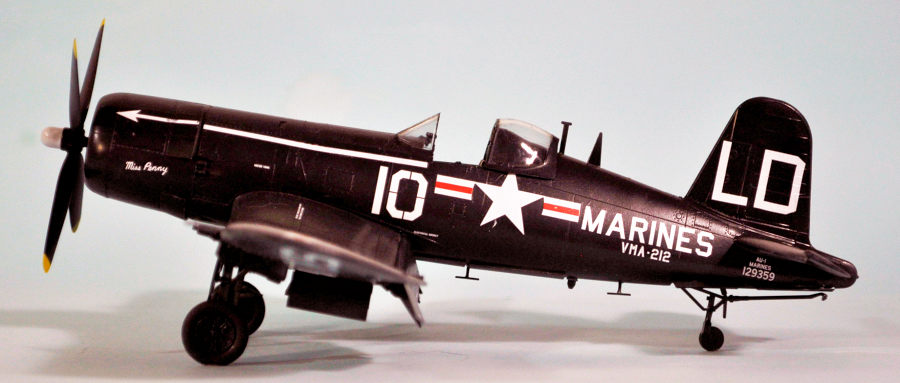
Hasegawa 1/48 AU-1 Corsair
| KIT #: | 09437 |
| PRICE: | $29.95 'Used' |
| DECALS: | Two options |
| REVIEWER: | Tom Cleaver |
| NOTES: | Victory Productions decals |

| HISTORY |
By
1950, the Corsair had more than proven itself in the Pacific War as both an air
superiority fighter and a fighter bomber that could carry a heavier load and
deliver it more accurately than the Curtiss SB2C Helldiver. In 1950, the Corsair
literally saved the day in the opening phase of the Korean War, when two
squadrons of Marine F4U-4s arrived in-theater at the end of June as the air
component of the Marine Provisional Brigade, the first stateside reinforcement
to arrive since the outbreak of war. Operating from the escort carriers Sicily
and Badoeng Strait, the “Death Rattlers” of VMF-223 and the “Blacksheep” of
VMF-214 provided desperately-needed battlefield ground support for the Marine
Brigade and the other UN forces holding out in the Pusan Perimeter. Unlike the
Air Force F-80s that could only operate from airfields in Japan and had a 15
minute loiter time over the battlefield, or the F-51D Mustangs that operated
from forward airstrips only during the day, the
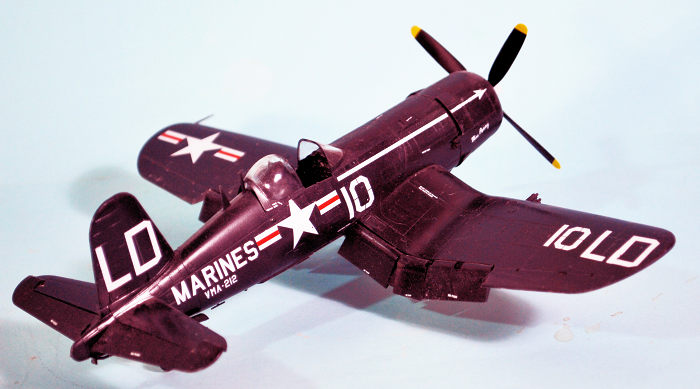 Corsairs could constantly
maintain a flight over the battlefield on-call, and could launch strikes from
the carriers operating 40 miles off the coast in the Sea of Japan that could be
overhead in 30 minutes. And when a typhoon stopped air operations in Japan, the
two carriers were still able to operate off the Korean peninsula. In addition,
the Corsair’s R-2800 radial engine could take serious flak damage and still
bring pilot and plane back to the ship, unlike the F-51D that could be brought
down with a single .30-caliber bullet in its radiator. After saving the day at
the Pusan Perimeter, the Corsairs - flown by Marine and Navy pilots - saved
their “mud Marine” brothers at Chosin following the Chinese intervention in the
war that November and during the breakout from North Korea in December.
Corsairs could constantly
maintain a flight over the battlefield on-call, and could launch strikes from
the carriers operating 40 miles off the coast in the Sea of Japan that could be
overhead in 30 minutes. And when a typhoon stopped air operations in Japan, the
two carriers were still able to operate off the Korean peninsula. In addition,
the Corsair’s R-2800 radial engine could take serious flak damage and still
bring pilot and plane back to the ship, unlike the F-51D that could be brought
down with a single .30-caliber bullet in its radiator. After saving the day at
the Pusan Perimeter, the Corsairs - flown by Marine and Navy pilots - saved
their “mud Marine” brothers at Chosin following the Chinese intervention in the
war that November and during the breakout from North Korea in December.
The F4U-4 did engage in air combat in 1951, when Solomons ace Captain Phil DeLong, flying off USS Bataan with VMF-312 shot down two North Korean Yak-9s, while his wingman 1st Lt. Harry Daigh shot down one and sent a second one smoking that went down on the way home. The introduction of the MiG-15 jet wrote finis to the Corsair in the air-to-air role, though Captain Jesse Folmar did manage to shoot down a MiG-15 that attacked he and his wingman on September 10, 1952. However, the MiG’s four friends then shot Folmar down a few minutes later. He bailed out and was quickly rescued. The Corsair’s days as an air superiority fighter were over.
While the
Marines were happy with the Corsairs they had, they pressed Vought for a
dedicated attack version that would incorporate the lessons being learned in
Korea. During 1951, Vought turned to creating what was first known as the F4U-6.
Based on the F4U-5 airframe with all-metal outer wings, this Corsair used the
R-2800-83W engine that provided 2,300 hp, using a single-stage supercharger,
since it would only operate at low altitude.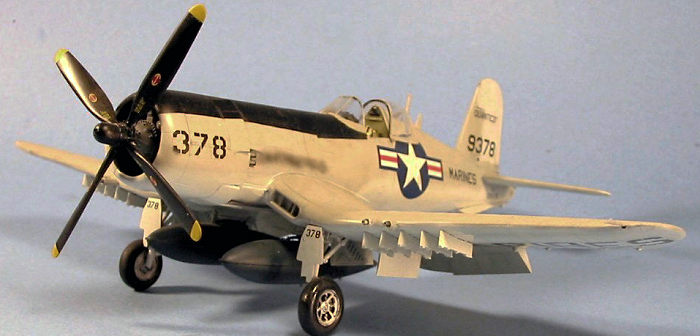 The airframe featured extensive
added armor plate on the lower fuselage to protect the pilot and fuel tank from
ground fire, with the oil coolers moved inside the fuselage for added
protection. There were ten stations on the outer wing, capable of carrying
either six 250-pound bombs or ten 5-inch HVARs, with the fuselage pylons each
capable of carrying a 1,000-pound bomb. Like the F4U-5, the new Corsair carried
an armament of four 20mm cannon. The XF4U-6 first flew in January, 1952; in
recognition of its attack role, the designation was changed when production
began to AU-1. The first of 250 produced arrived in Marine squadrons that
summer.
The airframe featured extensive
added armor plate on the lower fuselage to protect the pilot and fuel tank from
ground fire, with the oil coolers moved inside the fuselage for added
protection. There were ten stations on the outer wing, capable of carrying
either six 250-pound bombs or ten 5-inch HVARs, with the fuselage pylons each
capable of carrying a 1,000-pound bomb. Like the F4U-5, the new Corsair carried
an armament of four 20mm cannon. The XF4U-6 first flew in January, 1952; in
recognition of its attack role, the designation was changed when production
began to AU-1. The first of 250 produced arrived in Marine squadrons that
summer.
With a full combat load of 8,200 pounds of ordnance, the AU-1 weighed 20 percent more than a fully-loaded F4U-4, had a maximum speed of 238 mph at 9,500 ft. Loaded with a more common 4,600 -pound load and a 150-gallon drop-tank maximum speed was 298 mph at 19,700 ft. Empty of ordnance, maximum speed was 389 mph at 14,000 ft.
The Marines finally got rid of the last of their beloved Corsairs in 1957, by which time the few airframes left were primarily used as personal transportation by senior Marine aviators engaged in nostalgia.
Following the end of the Korean War in July 1953, a total of 96 AU-1s were provided to the French Aeronavale under MDAP. They flew in combat during the last six months of the first Indochina War and also saw service in the Algerian conflict, finally being retired from service in 1964.
| THE KIT |
Hasegawa introduced kits of the final Corsairs - the F4U5, AU-1 and F4U-7 in 2000. In typical Hasegawa fashion, the kits were the same from the firewall aft, differing only in the engine cowlings, which were the only primary visual distinction between the three versions.
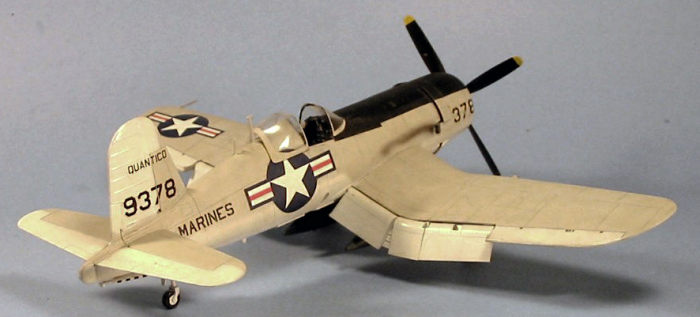 Hasegawa
managed to make a molding mistake producing the kits, with a noticeable “step”
in the forward fuselage where the different noses were catered for. Solving the
problem is simple, applying some Mr. Surfacer to the area and sanding it smooth,
then rescribing the lost surface detail there.
Hasegawa
managed to make a molding mistake producing the kits, with a noticeable “step”
in the forward fuselage where the different noses were catered for. Solving the
problem is simple, applying some Mr. Surfacer to the area and sanding it smooth,
then rescribing the lost surface detail there.
As is typical with Hasegawa, there were several limited-run releases of the kit. I used the first release that featured markings for the often-photographed Au-1 based at Quantico in 1955-57 in the new gull grey/white paint scheme, and the second release of the kit as an F4U-6 in the Naval Reserves. While I did these two models 20 years apart, I used the same sheet of decals for both, the Victory Productions decal sheet for the F4U-5N and AU-1 released in 2002 that is now long out of production.
While the AU-1 kits have been out of production since 2006, the F4U-5N, AU-1 and F4U-7 can still be found on eBay for prices that are close to the original MSRP. The Victory Productions decal sheet is now a collector’s item and commands collector’s prices.
| CONSTRUCTION |
I first built the “Quantico” AU-1 back in 2002, using the then-new Victory Productions decal sheet. The VMA-212 AU-1 was done last fall as part of the “Korea: The Forgotten War” group build over at iModeler.
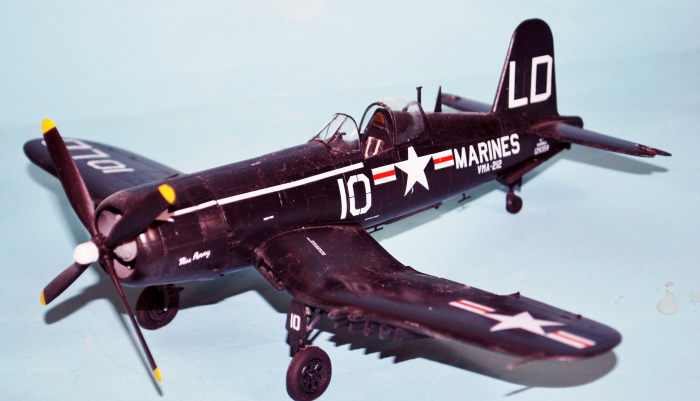 The
following is from my 2002 review here of the F4U-5N kit. There were no
differences in creating either of these two AU-1s:
The
following is from my 2002 review here of the F4U-5N kit. There were no
differences in creating either of these two AU-1s:
The cockpit is simple, but then the cockpit of the real thing was much simplified as compared to the preceding Corsairs. I also used some photo-etch levers to flesh out the throttle quadrant.
On these kits, I used a Pro-Modeler seatbelt decal for the “Quantico” AU-1, which I applied to some lead foil from a wine bottle, then cut free. The foil allows the seat belt to be posed more realistically that would otherwise be the case with a decal.
I used Eduard photoetch seatbelts for the Korean War AU-1.
Other than that, I built the models “out of the box” according to the instructions and encountered no difficulties other than needing to fill in and sand smooth the mold glitch in the forward fuselage.
| COLORS & MARKINGS |
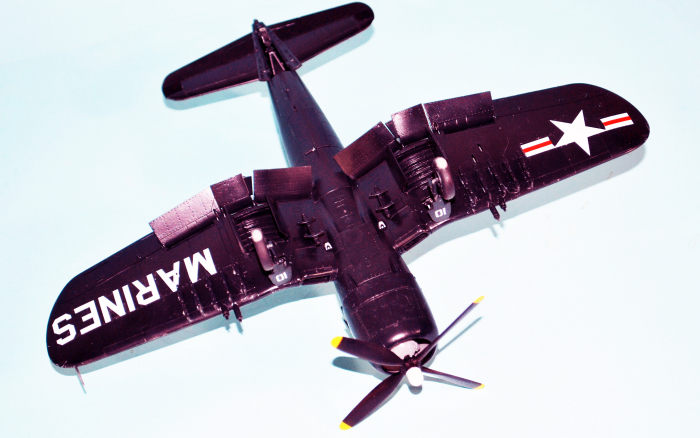 The
“Quantico” AU-1 was painted with Gunze-Sangyo “Light Gull Grey” and “Gloss
White.” The VMA-212 AU-1 was painted with Xtracrylix “Midnight Blue.”
The
“Quantico” AU-1 was painted with Gunze-Sangyo “Light Gull Grey” and “Gloss
White.” The VMA-212 AU-1 was painted with Xtracrylix “Midnight Blue.”
The VMA-212 AU-1 was also done in decals by Micro-Scale back in the 1980s; that sheet can still be found and is useful since it is not as expensive as the Victory Productions sheet that is now a collector’s item. The national insignia on this sheet is a bit oversize.
The VPD sheet is excellent quality, and even after 20 years the decals for the VMA-212 airplane still worked perfectly and went down without problem under a coat of Micro-Sol, just like they had done back in 2002 with the “Quantico” model.
I unmasked the canopies and positioned them open. I opted not to use the underwing ordnance since the rockets provided aren’t that good, but plan to use other ordnance on the VMA-212 airplane.
| CONCLUSIONS |
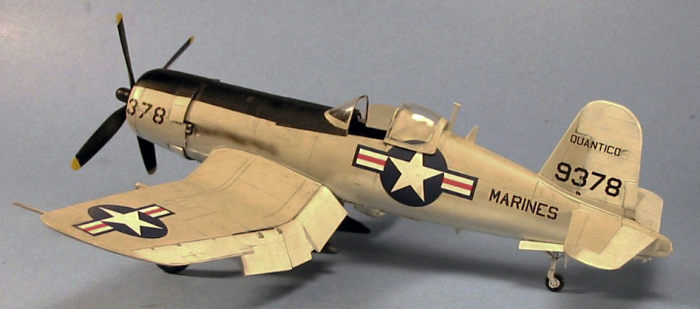 For Corsair
lovers, the Hasegawa kits are still the only option for doing the late-model
airplanes. They still hold up in comparison with other more recent kits and
result in an excellent model. As noted, they can be found at dealers on eBay for
very reasonable prices if you shop around.
For Corsair
lovers, the Hasegawa kits are still the only option for doing the late-model
airplanes. They still hold up in comparison with other more recent kits and
result in an excellent model. As noted, they can be found at dealers on eBay for
very reasonable prices if you shop around.
4 March 2021 Copyright ModelingMadness.com.
All rights reserved. Review kits courtesy of my wallet. If you would like your product reviewed fairly and
fairly quickly, please
contact
the editor
or see other details in the
Note to
Contributors.
Back to the Main Page
Back to the Review
Index Page
Back to the Previews Index Page